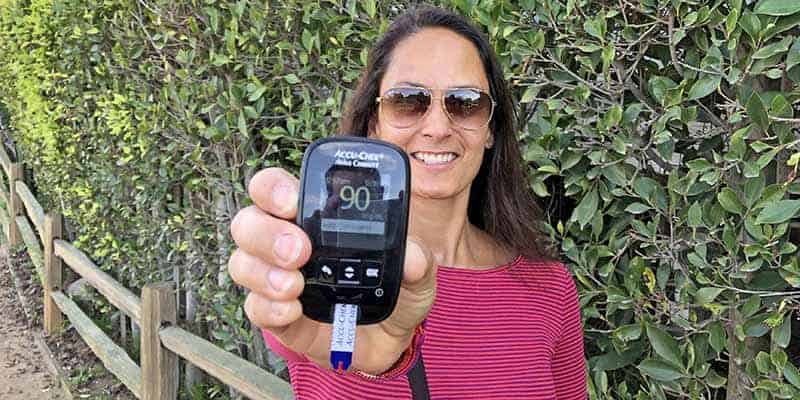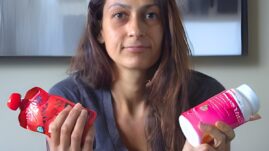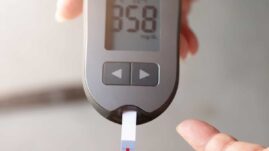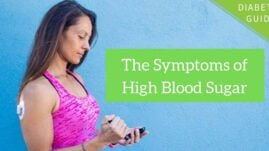Your blood glucose (sugar) levels are a critical part of your overall health and your body’s ability to function properly.
For those of us with diabetes, striving to achieve “normal” blood sugar levels is a constant, hour-by-hour pursuit. And it isn’t easy.
In this article, we’ll look at normal blood sugar levels and goal ranges for people without diabetes and recommended blood sugar goals for people with prediabetes, type 1 diabetes, and type 2 diabetes.

Table of Contents
- Normal blood sugar ranges in people without diabetes (chart)
- Recommended blood sugar ranges in people with diabetes (chart)
- How do you know what your blood glucose level is?
- Diagnosing prediabetes, type 1, and type 2 diabetes
- Your A1c and blood sugar goals
- Your blood sugar isn’t just because of what you eat
- Final thoughts: Still frustrated with your blood sugar and A1c results?
Normal blood sugar ranges in people without diabetes (chart)
For a person without any type of diabetes, blood sugar levels are generally between 70 to 99 mg/dL (3.9 to 5.5 mmol/L) fasting and under 140 mg/dL (7.8 mmol/L) after a meal.
Here are the normal blood sugar ranges for a person without diabetes according to the NIH:
| Fasting Blood Sugar (e.g., In the Morning Before Eating) | Less than 100 mg/dL (5.6 mmol/L) |
| 1 to 2 Hours After a Meal | Less than 140 mg/dL (7.8 mmol/L) |
| 2 to 3 Hours After a Meal | Less than 100 mg/dL (5.6 mmol/L) |
Recommended blood sugar ranges in people with diabetes (chart)
Here are the generally recommended blood sugar ranges for a person with diabetes according to the ADA:
| Fasting Blood Sugar (e.g., In the Morning Before Eating) | 80 to 130 mg/dL (4.4 to 7.2 mmol/L) |
| 1 to 2 Hours After a Meal | Less than 180 mg/dL (10.0 mmol/L) |
Learn more about fasting and after-meal blood sugar levels in: Blood Sugar Chart: Blood Sugar and A1c Targets.
How do you know what your blood glucose level is?
Unless it’s fairly high or low, you generally can’t feel what your blood sugar level is. And in fact, you may not even be able to tell from physical symptoms when it is high or low.
The best way to know your blood sugar level is to either check it with a traditional glucose meter or use a CGM (continuous glucose monitor) device.
For a glucose meter, you do a finger-stick with a lancet, put a drop of blood onto a test strip, and then insert the strip into the meter for a reading. With a CGM, readings are taken from the interstitial fluid (the fluid between the cells) about every 5 minutes via a sensor inserted just under the skin.
Diagnosing prediabetes, type 1, and type 2 diabetes
The following are tests that may be used by your healthcare provider to determine if you have diabetes:
Tests used to diagnose diabetes
Fasting plasma glucose test
This test measures your glucose level at a single point in time, typically after you have been fasting (nothing to eat or drink except water) for at least 8 hours.
Random glucose test
This test measures your glucose level at a single point in time and may be given at any time, whether you have fasted or not.
Oral glucose tolerance test (OGTT)
For this test, you will have a blood sample taken after fasting for at least 8 hours. Next, you will drink a liquid high in sugar and will have another blood sample taken after 2 hours to see how your blood glucose levels have changed.
(In those who are pregnant, glucose will be checked every hour for 2 to 3 hours to test for gestational diabetes.)
A1c test
This blood test reflects your average glucose levels over the previous 2 to 3 months. You can eat and drink prior to having an A1c test.
A repeat of these tests is typically required to confirm a diabetes diagnosis.
Test results for diagnosing diabetes (chart)
The following blood sugar and A1c results (a measure of glucose control over the previous 2 to 3 months) are used to diagnose prediabetes and diabetes, according to the ADA:
| A1c | Fasting Glucose | 2 Hours After a Meal | |
| Prediabetes | 5.7 to 6.4 percent | 100 to 125 mg/dL (5.6 to 6.9 mmol/L) | 140 mg/dL to 199 mg to dL (7.8 to 11.1 mmol/L) |
| Diabetes (type 1 or type 2) | 6.5 percent or higher | 126 mg/dL (7.0 mmol/L) or higher | 200 mg/dL (11.1 mmol/L) or higher |
Learn more about diagnosing diabetes in: Types of Diabetes.
Please note: Type 1 diabetes tends to develop very quickly, which means that by the time symptoms are felt, blood sugar levels are often well above 200 mg/dL all the time. For many people, symptoms come on so quickly that they are dismissed as a lingering flu or another seemingly ordinary virus.
By the time blood sugar levels are checked, many people with undiagnosed type 1 diabetes may have levels above 400 mg/dL or higher.
If you suspect that you or a loved one has type 1 diabetes, visit your primary care or urgent care immediately and ask for a urine test to measure ketones in addition to checking blood sugar levels and A1c.
Read more about ketones at diagnosis in: How to Avoid Diabetic Ketoacidosis (DKA).
Your A1c and blood sugar goals
Managing any type of diabetes is far more complicated than giving a person some insulin and telling them to keep their blood sugars within X and X mg/dL. If you’ve lived with diabetes for more than a few days, you probably already know this.
What is A1c?
“A1c, also known as hemoglobin A1c, HbA1c, glycated hemoglobin, or glycohemoglobin, is a blood test that measures your average blood sugar over the last 2 to 3 months,” explains Christel Oerum, MS, in Diabetes Strong’s guide to lowering your A1c.
Although the test reflects the glucose attached to hemoglobin (the protein in your red blood cells) over the past 2 to 3 months, the blood sugar levels in the 2 weeks leading up to your A1c test influence the results the most. Essentially, higher blood sugar levels during this period result in more glucose binding to hemoglobin.
Translating your A1c to a blood sugar level
Using this simple calculator from the ADA, you can translate your most recent A1c result to an “eAG,” or “estimated average glucose level.”
You can also use this translation when working to improve your A1c and achieve closer to normal blood sugar levels.
For instance, if you know an A1c of 6.0 percent equates to an average blood sugar level of 126 mg/dL (7.0 mmol/L), then you can look at your current blood sugar results on your CGM and meter and pinpoint what time of day you’re frequently higher than that level.
| A1c | eAG |
| 6 percent | 126 mg/dL |
| 7 percent | 154 mg/dL |
| 8 percent | 183 mg/dL |
| 9 percent | 212 mg/dL |
| 10 percent | 240 mg/dL |
| 11 percent | 269 mg/dL |
| 12 percent | 298 mg/dL |
Normal blood sugar levels in a person without diabetes can result in an A1c of 5.6 percent or lower.
Just a decade or two ago, it was rare for a person with type 1 diabetes to achieve an A1c result below 6.0 percent.
Thanks to new and improved insulin and better technology like CGMs, smarter insulin pumps, and hybrid closed-loop technology (which allows some insulin doses to be automatically delivered), more people with diabetes are now able to safely achieve A1c levels in the higher 5 percent range.
Why your A1c matters
In a nutshell: Your A1c is one of the clearest indicators of your risk for developing diabetes complications like neuropathy (nerve damage), retinopathy (a type of eye disease), nephropathy (kidney disease), cardiovascular disease, and severe infection in any part of your body that requires healing.
For instance, a small cut on your toe could become infected due to high blood sugars, struggle to heal, and become severe enough that the infection could require an amputation.
The general guidelines from the ADA recommend an A1c level of less than 7.0 percent to help prevent diabetes-related complications. Lowering your A1c closer to 6.0 percent may further reduce the risk of microvascular complications (those impacting the small blood vessels), such as those affecting the eyes (retinopathy), kidneys (nephropathy), and nerves (neuropathy).
Some people with diabetes aim for A1c levels in the 5s and lower — especially those who follow strict low-carb diets like the ketogenic diet and the Bernstein diet. However, this hasn’t been proven in research as especially necessary, nor is it reasonably achievable for the larger population of people with diabetes.
It’s also important to remember that your blood sugar levels and your A1c are just information that tells you whether your body needs changes in factors like insulin, other diabetes medications like metformin, your nutrition, or your physical activity.
If you don’t like the number you’re seeing on your glucose meter or your A1c results, use that number as motivation to make changes (with the support of your diabetes healthcare team) in how you safely manage your diabetes in order to get different results.
Determining the right A1c goal for you
Just because a blood sugar range of 70 to 130 mg/dL (3.9 to 7.2 mmol/L) is considered the healthiest for people with diabetes doesn’t necessarily mean that’s the appropriate goal range for you — especially if you have type 1 diabetes, or take insulin as a person with type 2 diabetes.
The reason this may not be the right goal for you is that extremely tight blood sugar management in people taking insulin can potentially lead to frequent hypoglycemia (low blood sugar), which can be dangerous.
Achieving extremely tight blood sugar management also generally requires a strict nutrition plan, very frequent blood sugar monitoring, precise medication management, and, often, years of experience studying your blood sugar levels.
Your A1c goals should be set in close consultation with your medical team, who can help balance the benefits and risks of different targets based on your health status, lifestyle, and preferences.
Older adults with cognitive or functional limitations or severe comorbidities (major additional health issues) may have a less-stringent A1c goal of less than 8 percent.
It is also worth noting that your A1c targets can change over time as your diabetes management evolves.
A1c goals should be individualized
“A1c goals should be individualized based on the individual capabilities, risks, and prior experiences,” explains Gary Scheiner, MS, CDCES, founder of Integrated Diabetes and author of Think Like a Pancreas.
“For example, we generally aim for very tight A1c levels during pregnancy and more conservative targets in young children and the elderly.”
Scheiner highlights important factors that could justify aiming for a higher A1c, like hypoglycemia unawareness, a condition in which a person with diabetes no longer feels the typical warning signs of low blood sugar.
Hypoglycemia unawareness can put you at significant risk for severe low blood sugars that have the potential to be life-threatening. To reduce that risk, you would aim for higher target blood sugar ranges.
“Someone with significant hypoglycemia unawareness and a history of severe lows should target higher blood glucose levels than someone who can detect and manage their lows more effectively,” adds Scheiner.
“And certainly, someone who has been running A1cs in double digits [like 10 percent or higher] for quite some time should not be targeting an A1c of 6 percent … better to set modest, realistic, achievable goals.”
Read about reducing your A1c in: How to Lower Your A1c and How to Lower A1c Naturally.
Your blood sugar isn’t just because of what you eat
It’s easy to believe that your blood sugar levels are impacted only by what you eat and how much you exercise, but people with type 1 and type 2 diabetes who check their blood sugars frequently could tell you otherwise.
It’s especially important to keep this in mind when looking at your own blood sugars and your goals, because there are certain variables and challenges that impact blood sugar levels that you can’t always control.
For example:
- Menstrual cycles: often raise blood sugar and insulin needs
- Adrenaline rushes from competitive sports, heated arguments, roller coaster rides, and other intense situations: raise blood sugar and insulin needs
- The common cold and other illnesses: usually raise blood sugar and insulin needs
- Hormonal changes due to puberty and healthy growth in young adults: raise blood sugar and insulin needs
- An injury that increases overall inflammation levels: raises blood sugar and insulin needs
- Gluconeogenesis during anaerobic exercise: raises blood sugar and insulin needs
While you can’t necessarily prevent these factors that affect your blood sugar from occurring, you can work with your diabetes healthcare team to adjust your insulin, other diabetes medications, nutrition, and activity levels to help compensate for them when they do occur.
For example, when engaging in anaerobic exercise such as weightlifting, many people with type 1 diabetes find it necessary to take a small bolus of insulin prior to or during their workout because anaerobic exercise can actually raise blood sugar.
Final thoughts: Still frustrated with your blood sugar and A1c results?
Your blood sugars and your insulin or medication needs never stay in one place. If you gain weight or lose weight, your insulin and medication needs will change. If you become more active or less active, your needs will change. If you make drastic or even small changes to your nutrition, your needs will change.
Working with your diabetes healthcare team and diabetes coaches who can teach you how to make changes in your overall diabetes management plan is essential. Diabetes is a lifelong learning process.
Take a deep breath and be patient. If you don’t like what you’re seeing on your glucose meter, don’t get mad … get studying! Take good notes and work with your team to make changes to reach your goals.





santa sisco
my weight is 96 pounds. My sugars are high and I can no longer take metformin because it makes me sick. My doctor wants me to take ozempic but I will lose more weight. What can I take to lower my A1C?
Christel Oerum, MS
We have a few articles on how to lower your A1c, this is the latest: https://diabetesstrong.com/how-to-lower-a1c-naturally/
You don’t mention what your diagnosis is but based on the medication your doctor prescribes I’m guessing Type 2 diabetes. If you haven’t already, I would ask your doctor for a C-peptide and an “autoantibodies” test. Just to make sure you have the right diagnosis and are being treated with the appropriate medication
Zeleke Aklilu
Hgba1c testing is very expensive in my country is there any other cheap method to know hgba1c?
Diabetes medications are also expensive in my area is there cheaper way to get diabetes medication?
Kimberly F Scott
I have been diagnosed as Type 2 diabetic in 2018 and I still don’t understand it. I have to watch myself, I tend to internalize my feelings. I want to learn more about how the kidneys are affected. I am also trying to learn foods I can eat on a budget. That is hard. I love the articles.
Leah
I get frustrated with My diabetes. I have a problem with Dawn phenomenon. I can have a Great blood sugar of 100 and not eat anything before I go to bed and the next morning it can be anywhere from 180- 210. My a1c has been stuck at 7.6. And since My surgery it has made it that much harder to control. I was taking glipizide 10 mg 2x aday now I had to add insulin to that medication. Any suggestions on how I can get My A1c down and get off insulin?
Thank-You for Your advice in advance.
Christel Oerum
I’d suggest you try a CGM to see if your blood sugar is running high all night or only early morning. It can also help you pinpoint when your blood sugars are higher than you want them to be. Since you’re on insulin your insurance most likely will pay for a CGM, you can also try requesting a free trial (from Dexcom or Libre).
I’ve also created some videos where you can find ideas on how to lower your A1c, you can find them here on our YouTube channel: https://youtube.com/playlist?list=PLP1_U1UAmvW5kr7gSGoobvX14S70CSP4g&si=-0xuikdn8m3U-9wU
apuz
I was diagnosed with type two diabetes, not long ago. My A1c was 10.1. Still waiting to take another blood test to see if I was able to lower that. One thing that confuses me is when I should test myself. I know I should test myself in the morning while fasting. I know I should test myself after meals. It’s just the whole timing thing. I am confused about. Most people say test two hours after your meal. Is that two hours from the first bite of your meal or two hours from when you finished your meal Last bite?
Christel Oerum
Most doctors will ask you to measure in the morning, to know your fasting blood sugar. Before (the first bite) and 2 hours after (finishing) meals to better understand how your blood sugars react to meals
Amy
I have been frustrated with my fasting blood glucose levels. I am the type to fast, get my kids off to school then about an hour and a half after waking, I get around to having my blood work. What I didn’t realize is that as soon as you are up and about, your glucose automatically begins to rise to support your muscles needs. So when I was checked, my levels were in the 110-120 range. This concerned my dr. I asked for an Rx for the Dexcom G7 monitor. My insurance refused to pay for it unless I was injecting insulin three times daily. This is how they keep you from being healthy! I paid out of pocket for it and found that before rising out of bed, my glucose numbers were perfect. It has been a game changer for me and an eye opener for my dr who did not really understand how glucose rises and falls. I have to say, my diet is much better now that I can see how certain foods effect my blood levels. I have to watch my numbers but don’t need to be on medication which was what my dr was headed down the road for me!
Patrick S
I am 60 year old male who has recently been diagnosed type 2 diabetes. I was on 750 mg once A-day of metformin. After 3 weeks I began to throw up my arms and legs felt very weak so it was on a weekend did not know what to do I was scared. It was electric acidosis. So the next day I did not take the met Foreman. I felt much better the next day. I called the nurse to my doctor told them. The problem they said if I took the medicine it would be my own decision until I can see the doctor what I’m trying to figure out is what is. A normal blood glucose level when I tested it was 102 the nurse said that was low. Yet everywhere I read it says something about 99 to a 100 and something? What is a good blood glucose level to have and keep because? I am so unsure mine keeps bouncing anywhere from 157 to 211 and then it pops back down to a 140. Something or a 150 something or even a 122 a 138? When I wake up in the morning could someone please help me understand? This disease better thank you very much for anything you can tell me.
Christel Oerum
I’m sorry to hear that you’re having reactions to Metformin. It’s important that you see your doctor and get a new treatment plan to help you manage your blood sugars.
A 102 mg/dl blood sugar is not considered low but is considered within the normal range. We should each work with our doctors to set individualized blood sugar goals but the high-level guidelines suggest aiming for blood sugars between 70-180 mg/dl.
To get a better understanding and so that you can ask all the questions you might have I’d suggest you ask your doctor to refer you to a Certified Diabetes Care and Education Specialist (CDCES)
Omar
Wish you all the best pal. Can you tell, at what time you are taking metformin? What’s your weight? What is your eating routine? Have you lately introduced any changes to your eatings habits due to this? Regards
Patricia Adauto
I have been on low carb high protein diet for 4 weeks. My diabetic sugar levels fluctuate to 105 to 112. I am type 2 diabetic. I have not taken any insulin at all. I test in the morning. Is it possible to fix this without medication?
Christel Oerum
I think you’ll find this article helpful, it explains to what extent type 2 diabetes is reversible https://diabetesstrong.com/is-type-2-diabetes-reversible/
Melaku
I am 57 years old and I am the petent of type 2 diabetes start from 2018. When the problen found for the first time my suger level was 254 and I started metformin and the suger level drop down with in a week. But stil I am on metformin 500mg morning and 500mg evening and my fasting suger level can not exceed more than 128mg/dl until and 2-3 hours after meal can not exceed more than 157mg/dl until now. But now my problem is I have diarrhea for 2 weeks the maximum frequencu to the bath room will be 3 times perday. But mostly 2 times a day, and I have stomach cramping in the night around 4am until I drink the water, and also I have a bitter test in my mouth in the morning. But after I drink a cup of water the stomach cramp will gone and I can get relif the whole day.
Can you advise me about the explaine problem?
Thank you!!
Tobias Oerum
Diarrhea and other digestive problems is unfortunately one of the most common side effects of Metformin. You can read more here: https://diabetesstrong.com/can-metformin-cause-diarrhea/
Bea Fox
No mention here that many meds (especially steroids) have the effect of making blood levels higher. Also, drugs taken for transplant patients have that effect.
Cassie
Yep. Some mental health drugs, particularly second generation antipsychotics, can also cause increased blood glucose levels.
Revy
Hi,
I am a 45 year old male, both my parents have a history of diabetic, i cought covid twice and before that my gkucose level was in the border line between normal and prediabetic. 2 weeks ago i checked and it shot up to 7, and a fasting level 146. Now i have been doing calories deficit (intermitent diet) for 2 weeks, I lost 3kgs and i monitor my sugar level 2-3x daily. Fasting Sugar level ranging 120-135, the odd thing is 2 hours after lunch my sugar level reading is 99-110 always lower than fasting. I am going to a doctor next month, Can I get an enlightment and opinion from You?
Thank You so much and I enjoy your explaination above.
Revy
Christel Oerum
Well done. The decrease could be because when you eat your pancreas secretes more insulin and your muscle and liver won’t put out as much glucose. Given the progress, you’re making your doctor might just tell you to continue doing what you’re doing and check in again in 2-3 months
Billu
This is called dawn phenomena please search it more and no need to worry you are in the transition state to reverse your pre diabetics